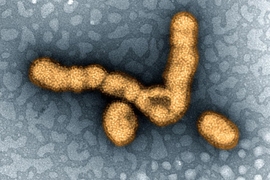Since December, an outbreak of swine flu in India has killed more than 1,200 people, and a new MIT study suggests that the strain has acquired mutations that make it more dangerous than previously circulating strains of H1N1 influenza.
The findings, which appear in the March 11 issue of Cell Host & Microbe, contradict previous reports from Indian health officials that the strain has not changed from the version of H1N1 that emerged in 2009 and has been circulating around the world ever since.
With very little scientific data available about the new strain, the MIT researchers stress the need for better surveillance to track the outbreak and to help scientists to determine how to respond to this influenza variant.
“We’re really caught between a rock and a hard place, with little information and a lot of misinformation,” says Ram Sasisekharan, the Alfred H. Caspary Professor of Biological Engineering at MIT and the paper’s senior author. “When you do real-time surveillance, get organized, and deposit these sequences, then you can come up with a better strategy to respond to the virus.”
In the past two years, genetic sequence information of the flu-virus protein hemagglutinin from only two influenza strains from India has been deposited into publicly available influenza databases, making it difficult to determine exactly which strain is causing the new outbreak, and how it differs from previous strains. However, those two strains yielded enough information to warrant concern, says Sasisekharan, who is also a member of MIT’s Koch Institute for Integrative Cancer Research.
He and Kannan Tharakaraman, a research scientist in MIT’s Department of Biological Engineering, compared the genetic sequences of those two strains to the strain of H1N1 that emerged in 2009 and killed more than 18,000 people worldwide between 2009 and 2012.
The researchers found that the recent Indian strains carry new mutations in the hemagglutinin protein that are known to make the virus more virulent. Hemagglutinin binds to glycan receptors found on the surface of respiratory cells, and the strength of that binding determines how effectively the virus can infect those cells.
One of the new mutations is in an amino acid position called D225, which has been linked with increased disease severity. Another mutation, in the T200A position, allows hemagglutinin to bind more strongly to glycan receptors, making the virus more infectious.
“Aggressive surveillance”
Sasisekharan points out that more surveillance is needed to determine whether these mutations are present in the strain that is causing the current outbreak, which is most prevalent in the Indian states of Gujarat and Rajasthan and has infected more than 20,000 people so far.
“The point we’re trying to make is that there is a real need for aggressive surveillance to ensure that the anxiety and hysteria are brought down and people are able to focus on what they really need to worry about,” Sasisekharan says. “We need to understand the pathology and the severity, rather than simply relying on anecdotal information.”
Learning more about the new strains could help public health officials to determine which drugs might be effective and to design new vaccines for the next flu season, which will likely include strains that are now circulating.
“The goal is to get a clearer picture of the strains that are circulating and therefore anticipate the right kind of a vaccine strategy for 2016,” Sasisekharan says.
David Topham, a professor of microbiology and immunology at the University of Rochester, agrees there is a strong need for more influenza surveillance.
“Western scientists are just not paying enough attention to what’s going on in such a large country as India. If anybody is collecting viruses and sequencing them, they’re not being entered into one of the more common databases where people can look at them,” says Topham, who was not involved in the research. “We’re missing a big piece of the puzzle.”
The research was funded by the National Institutes of Health, the National Research Foundation through the Singapore-MIT Alliance for Research and Technology, and the Skolkovo Foundation.











